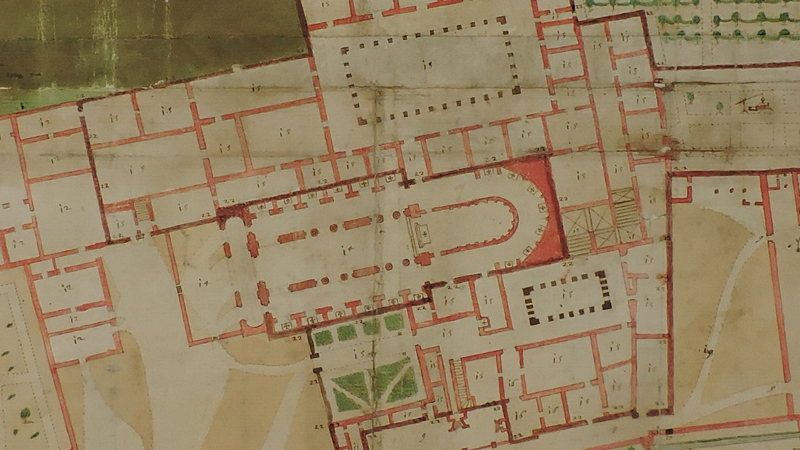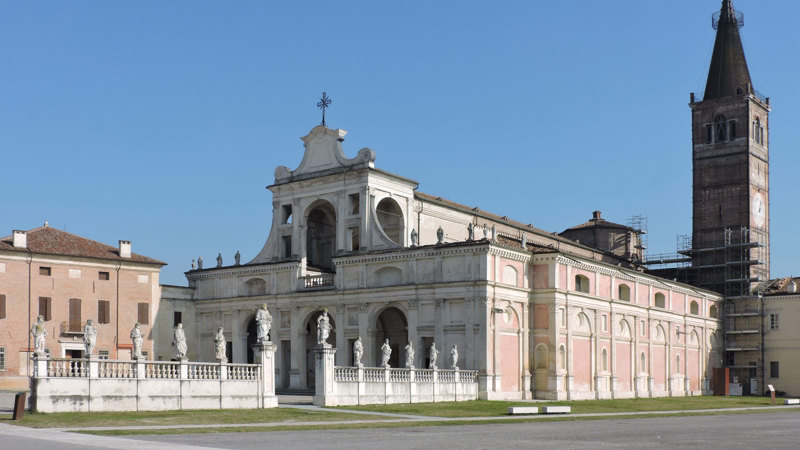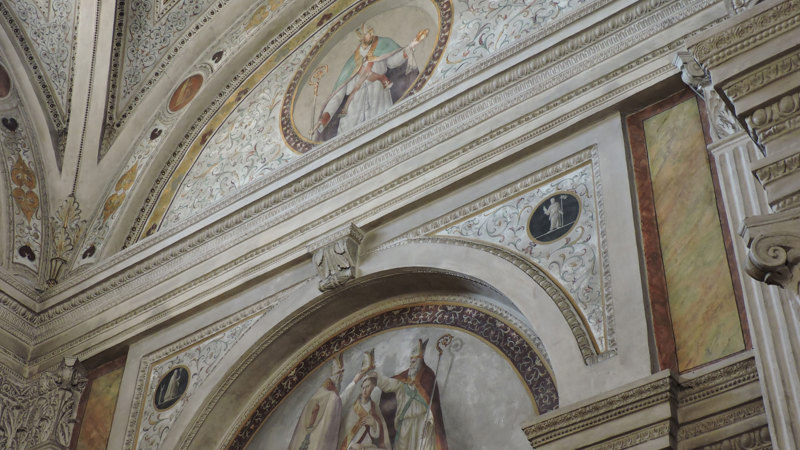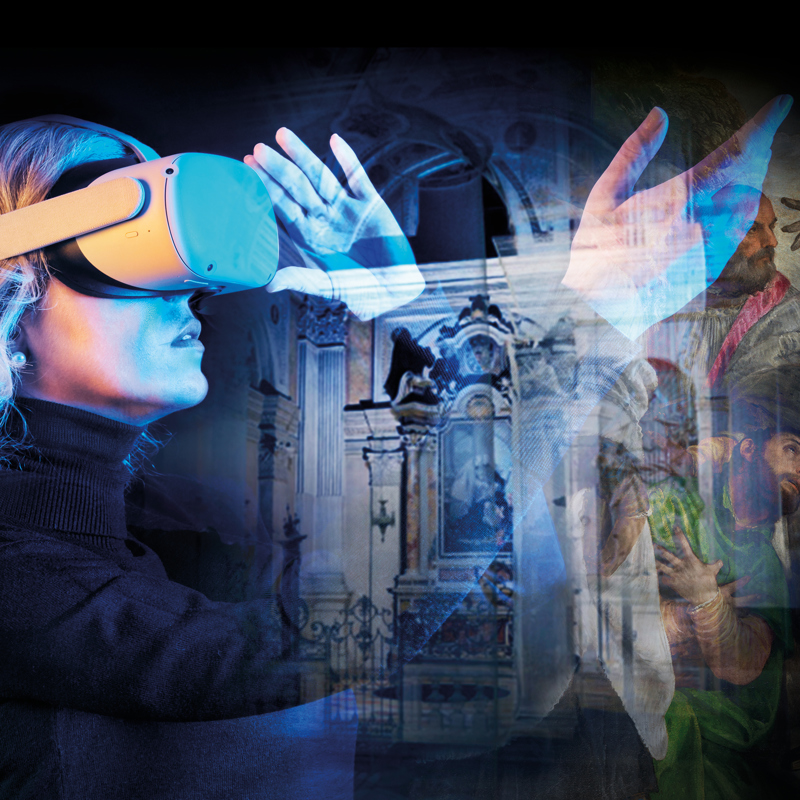Once the climax of the Chapel of Saint Nicholas in the church of San Benedetto al Po, near Mantua in Italy, Paolo Veronese’s painting of ‘The Consecration of Saint Nicholas’ has been in our collection since 1826 - just a couple of years after the National Gallery’s foundation.
The painting was removed from its original location during the Napoleonic Wars and in 1811 it made its way onto the London art market, where it was purchased with the idea that it would hang on the walls of a future National Gallery. Thanks to the power of digital technology, we are now able to reunite, for the first time in over 200 years, ‘The Consecration of Saint Nicholas’ with the chapel for which it was originally made.
Stepping back in time using virtual reality
The new virtual reality experience, ‘Virtual Veronese’, creates an opportunity to appreciate in full, the glory of Veronese’s altarpiece as emphasised by the magnificent architecture and frescoes that once surrounded it.
Taken together, the painting and its church encapsulate and reflect a moment of great crisis in European history when, in the mid-16th century, the Catholic Church tried to respond to the accusations being levelled at it by Protestant reformers.
The church of San Benedetto al Po
The church of San Benedetto al Po was part of a monastery belonging to the Benedictines of the Cassinese Congregation (a reformed wing of the Benedictine Order). By the 16th century, it was one of the largest and most important Benedictine monasteries in Europe, and attracted some of the greatest religious minds and artists of the period. In 1540-47, the church was substantially enlarged and given a Renaissance facelift by Giulio Romano, the innovative painter and architect, and Raphael’s prime pupil. It was during this time that the chapel of Saint Nicholas was built, one of a suite of new side chapels located on the south side of the church. The chapel was also decorated with frescoes depicting the life of Saint Nicholas, again designed by Giulio Romano and executed by his workshop. Then, some 20 years later, Paolo Veronese was commissioned by Don Andrea Asola, the abbot of San Benedetto al Po, to paint the altarpiece for the chapel.
The altarpiece
The altarpiece shows Saint Nicholas, dressed in green, kneeling in front of a senior bishop who stands on the steps of what we should interpret as the cathedral at Myra. According to the legend of Saint Nicholas, the bishopric of Myra (in Asia Minor, present-day Turkey) had become vacant and all the senior bishops had gathered to elect a new one. However, the night before the election the senior bishop had a vision in which God told him to appoint as bishop the first man who presented himself in the morning at the doors of the cathedral. That man was Nicholas, who had been guided there by God. In Veronese’s painting, Nicholas is shown surrounded by ecclesiastical figures, while on the far left he has included two men wearing eastern dress - presumably a reference to the location where this event occurred. Importantly, and in addition to the written accounts of the life of Saint Nicholas, Veronese also included an angel who descends from the heavens bearing the bishop’s staff and mitre with which Nicholas will soon be consecrated.
The subject of the consecration of Saint Nicholas is rarely depicted in art. Indeed, we know of only two other independent images of this scene, produced before the end of the 16th century. More usually, we find an image of one of Saint Nicholas’ more popular miracles, such as his resurrection of three boys who had been killed by a butcher and cured in a barrel, ready to be sold off as ham. Also popular were images of the saint throwing three pouches of gold coins through the window of a poor man’s house – his famous act of gift giving that led to the association between Saint Nicholas and the figure of Father Christmas. What makes the choice of subject of the altarpiece even more surprising is that the scene already appeared among the frescoes on the chapel’s walls.
Responding to a changing world
So why choose to repeat the story of the consecration of Saint Nicholas as the subject for the chapel’s altarpiece? Veronese’s patron, Bishop Asola, would have been responsible for the choice of subject matter and it would seem that he deftly used this altarpiece to present San Benedetto al Po in a positive way to the church authorities. In the 1560s, when Veronese produced this altarpiece, Asola and the monks of San Benedetto al Po found themselves under the glare of the Roman Inquisition, whose job it was to stamp out heresy. Several monks associated with San Benedetto al Po, including Asola himself, were investigated by the Inquisition for promoting heretical ideas and Asola was ordered to remove from the monastery’s famous library all its books written by Protestant reformers such as Martin Luther and Philip Melanchthon and burn them. The problem was that in the 1530s and 40s the monks of the Benedictine Cassinese Congregation, including those at San Benedetto al Po, had sought to learn from these Protestants, reading their texts, absorbing their ideas, all with the aim of trying to find a middle ground that would prevent the Church from splitting in two. Whilst such endeavours were perfectly acceptable in the earlier part of the century, by the 1560s the world had changed, and it was very clear that there was no hope of reconciling the Protestants and the Church of Rome. Consequently, the acceptance of Protestant ideas was no longer to be tolerated; seen as heresy, it had to be stamped out at all costs. The monks at San Benedetto al Po therefore found themselves on the wrong side of the debate.
Veronese’s altarpiece of 'The Consecration of Saint Nicholas' responds to this moment of crisis by presenting a very orthodox image that underlines the authority of the Pope in Rome as well as Asola’s allegiance to him. By including the figure of the angel bearing the bishop’s staff and mitre from Heaven, Veronese illustrates that Nicholas’ position as bishop was divined by God and that, like all bishops, his power comes directly from God. The Pope is head bishop within the Roman Catholic Church and so the painting confirms the God-given authority of the papacy; something that was questioned by the Protestants, but which was never doubted by the Benedictines of the Cassinese Congregation. Bishop Asola is therefore using Veronese’s painting to present a favourable image of himself (his portrait is included among the figures that surround Saint Nicholas) and his monastery, designed to make clear that his institution fully supported the papacy and promoted orthodox views.
Written by Dr Rebecca Gill, former Howard and Roberta Ahmanson Curator in Art and Religion.















